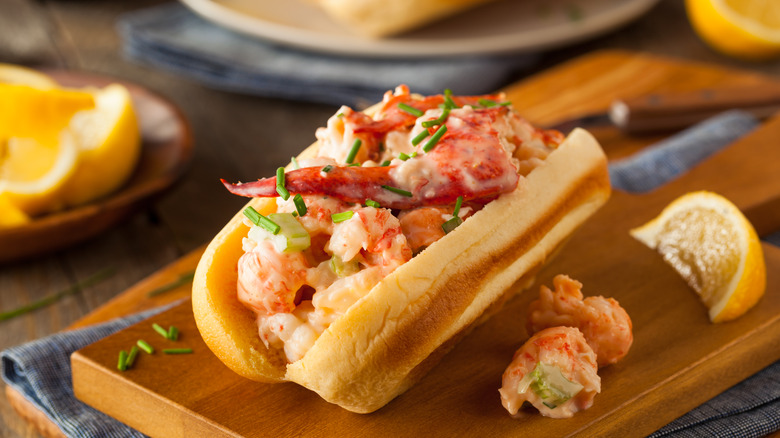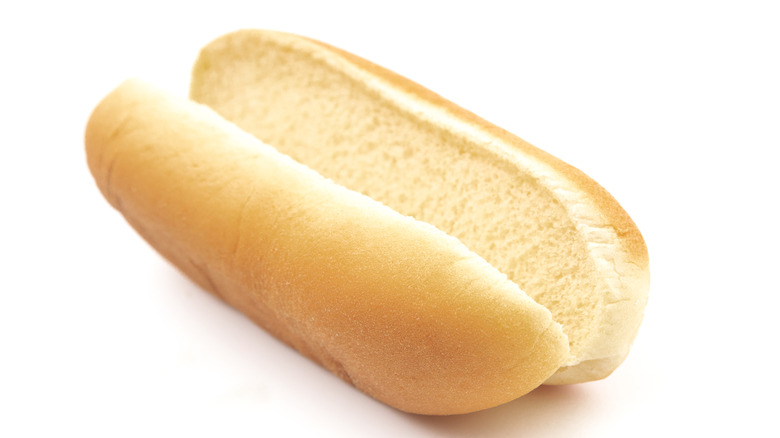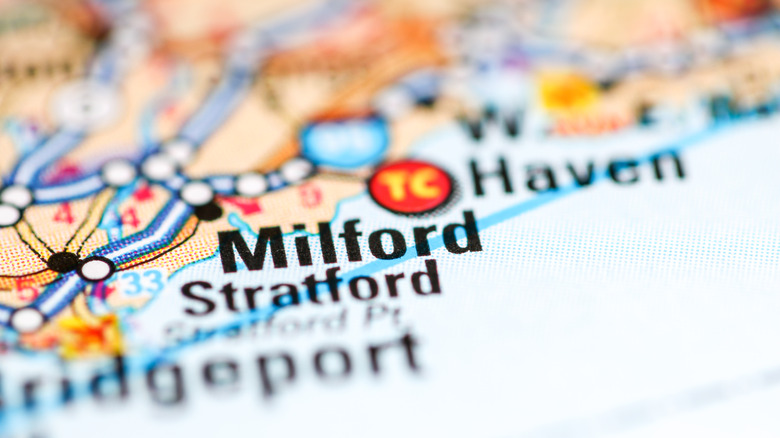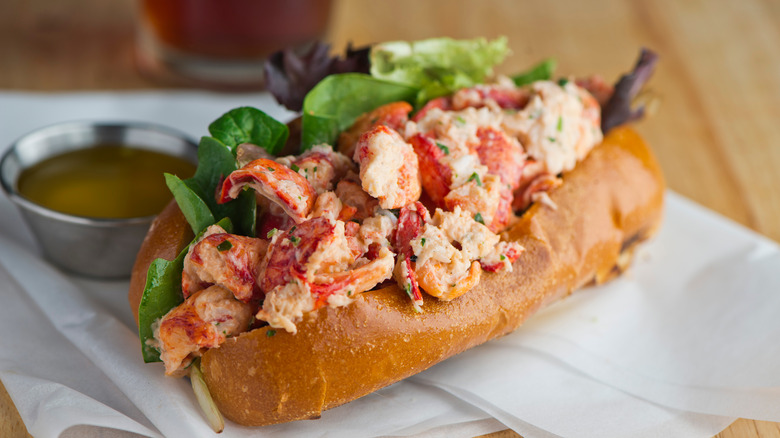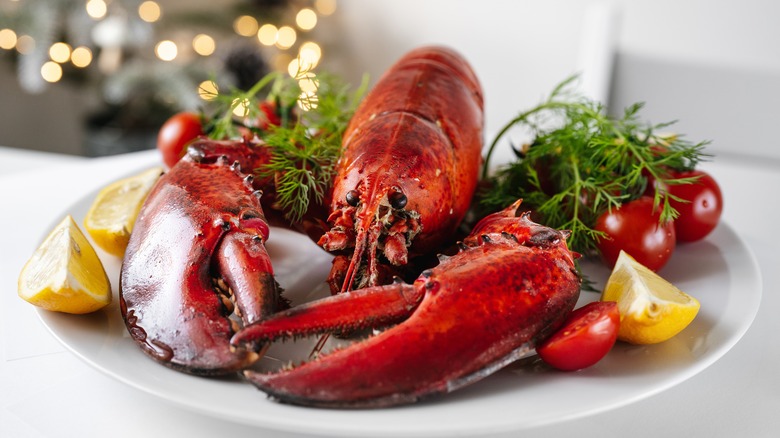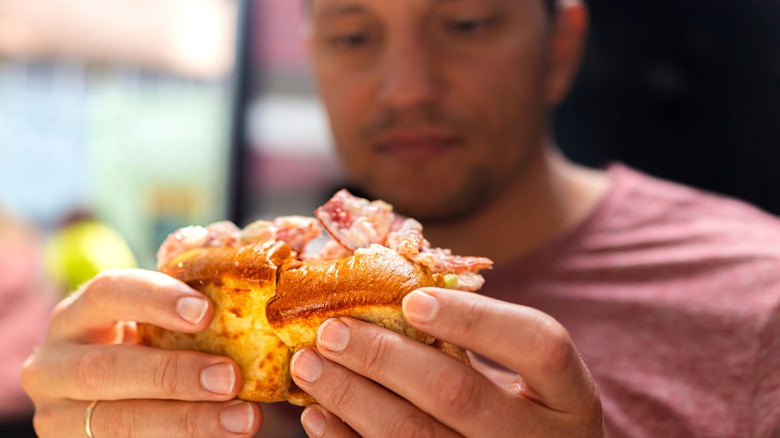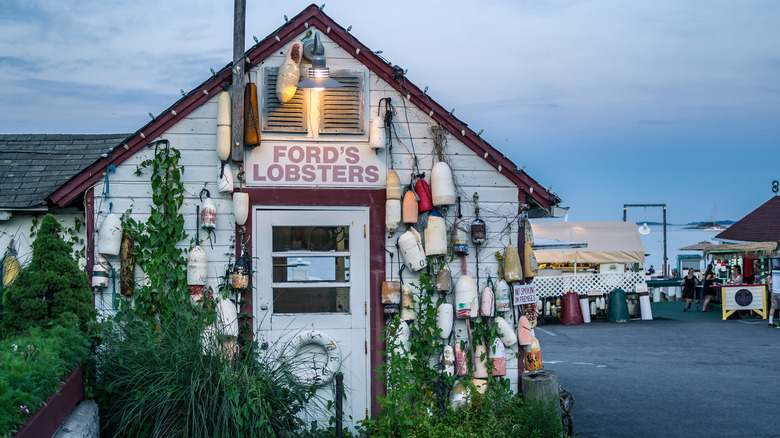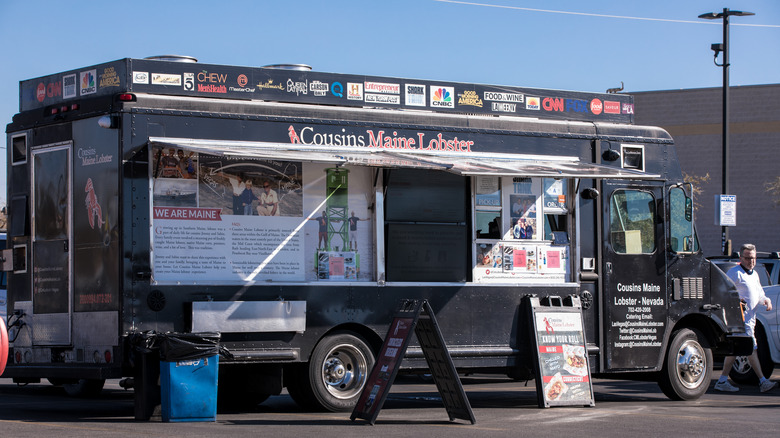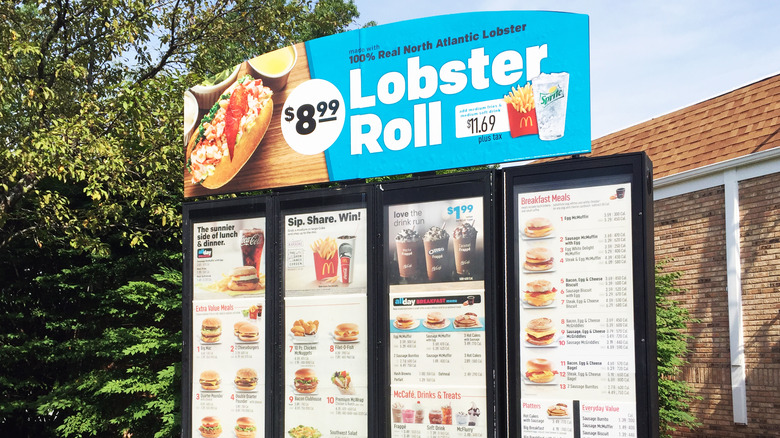The Storied History Of The Famous Lobster Roll
When it comes to shellfish, few critters have captured foodies' hearts quite like lobster. The crustacean is a favorite amongst seafood aficionados, with its rich, juicy flavor and abundance of meat in each serving. Whether you enjoy your lobster as an ingredient in a variety of seafood dishes or you are a pro at cracking one open and eating the meat straight from the shell, there are many ways to enjoy this particular food.
Depending on where you live in the United States, you may or may not have grown up with your summers filled with trips to the local seaside shack to enjoy a lobster roll. The handheld delicacy has been a New England staple for a century, with two states in particular holding a special place in their hearts for this dish. Connecticut and Maine both have their own unique histories (and unique recipes) for the lobster roll, which has grown into quite the friendly debate over the past several decades. Much like clam chowder, the lobster roll is woven into the culinary cultural fabric of New England. If you have ever wondered how the lobster roll came about, or how it grew into such an iconic New England dish over the years, we have a breakdown of the dish's history for you today.
One crucial ingredient did not hit the market until 1912
A lobster roll can be made with two simple ingredients: lobster meat and a toasted bun. While the lobster roll can have additional toppings, you need those two fundamental ingredients to get your dish started. Lobster rolls have been made using that basic formula since its earliest years, when it first arrived on the culinary scene in the early 20th century. One key event that led to the creation of the lobster roll came about in 1912, when soft buns were first developed. From there, people were able to come up with a new handheld method to enjoy lobster meat. In an interview with Daily Meal, Ben Conniff, co-founder and CMO of Luke's Lobster, points out that there was probably some version of a lobster sandwich before the roll as we know it today was invented, but those were likely made with some other variety of bread.
Lobster rolls today do not just come with any kind of bun. It closely resembles a hot dog bun, making it easier to hold and better for holding all of the lobster meat. The best variety of roll to use is one that has flat sides and can be split open, allowing you to stuff as much lobster into the roll as possible. Having flat sides also makes it easier to toast the roll, which is essential to getting that warm crunch with every bite.
Modern lobster rolls are thought to have originated in the 1920s
Once soft rolls were developed in 1912, it would only be a matter of time before the thought arose to use them to hold lobster meat. The earliest lobster rolls as we know them today appeared in 1927 in Connecticut. Specifically, diners at a restaurant called Perry's in Milford were the first to come across a new menu item called the lobster roll. It is believed that a customer requested one specifically, and restaurant owner Harry Perry thought the creation was so good that it was added as a regular meu offering.
The earliest iterations of the lobster roll at Perry's used thinner sandwich bread, which got quite soggy before customers had a chance to eat the entire meal. As a result, a different kind of split-top roll was developed to be able to hold all of the lobster meat, making it easier for diners to enjoy. For 50 years following the first roll served to a customer, Perry's proudly displayed a sign that read "Home of the Famous Lobster Roll," and no one dared to challenge that claim. The lobster roll is one of the few food items out there that has relatively agreed-upon origins.
A second version of the lobster roll has been served for nearly as long
It is generally agreed upon, especially in Connecticut, that what is believed to be the original lobster roll came out of Milford. There, they used hot lobster meat topped with melted butter on a split-top roll. But depending on where you live, you might be more familiar with a different style of lobster roll, one that has actually been around for nearly as long. This kind of lobster roll was also developed in New England, specifically Waldoboro, Maine.
There, customers at Moody's Diner have been able to order a lobster roll as well since the late 1920s. The recipe for this lobster roll is a bit different, however, with the Maine version being more of a cold lobster salad piled high on a split-top roll. If you visit Moody's Diner today, you can order both the hot and cold versions of the lobster roll. The Maine Diner in Wells, Maine, is also stated to be among the earliest homes of this specific kind of lobster roll. Since then, cold lobster salad-style rolls have been abundant at restaurants around Maine and New England, growing in popularity in step with their hot, buttery cousin.
Lobster was once considered a poor man's food
These days, lobster rolls are among one of the higher-priced menu items at any given restaurant. The price of lobster meat can vary based on that day's market price, but in the 21st century, it's usually a pricier tab. But back when lobster rolls were first invented, they were actually quite accessible. In fact, there was a time when lobster meat was considered a poor man's food and was something you would never find at a high-end establishment.
Once people caught on to how delicious lobster meat is, it grew in popularity. Lobster rolls, along with any other dish that uses lobster, started to appear on more and more menus nationwide. These days, lobster rolls have definitely shifted to more of a special occasion treat based on price alone, with some diners seeing prices as high as $40 per roll in the summer of 2022. That year's price hike was attributed to supply chain issues as a result of the COVID-19 pandemic, though fans of lobster will tell you that the meat has been rising steadily in price over the years.
The lobster roll's popularity boomed in the 1970s
For the first 50 years or so, lobster rolls were more or less a localized specialty, available up and down the New England shore at clam shacks and other seaside restaurants. While those "in the know" were aware of how great lobster rolls were, it took decades for the general population to catch on.
In the 1970s, a restaurant called Red's Eats in Wiscasset, Maine, which had already been selling its famous lobster roll for many years, started to promote it heavily. Later, further south in New England in the 1980s, Jasper White debuted a version of the lobster roll at Summer Shack in Massachusetts, also helping the item rise in popularity. Once word caught on, the sandwich spread nationwide.
Another boost in popularity came about in 1996. That year, a version of the Maine lobster roll appeared at Pearl Oyster Bar in New York City. And as they say, if you can make it there, you can make it anywhere. With its rise in notoriety in the northeast, the entire country soon caught on to what New Englanders had known since the 1920s: Lobster rolls are seriously delicious.
One state takes its lobster rolls very seriously
As the lobster roll developed over time, two distinct versions emerged. The first is a hot lobster roll served only with melted butter. The second is a cold lobster salad roll mixed with mayonnaise and any combination of additional toppings. Depending on where you live, you may find one kind of lobster roll to be more prominent than the other. In most cases, you will likely find the cold Maine-style lobster roll to be more common in restaurants across the country. But if you are from Connecticut, you know that there is only one way to serve a lobster roll, and that is hot with butter. After all, with Connecticut being the agreed-upon birthplace of the lobster roll, residents feel a sense of ownership and pride in this particular food item.
Locals know that "Hot is the only way to eat a lobster roll," as Chris Saley, owner of Bridge House Restaurant in Milford, told the Connecticut Post in 2010. Lobster wholesaler John Anagnos admitted in the same article that despite offering both hot and cold lobster rolls at his restaurant, City Fish Market in Wethersfield, the hot version was much more popular among regular customers. You might see a Connecticut local sneer at the thought of a cold lobster roll, but outside of the Nutmeg State, it is quite readily available and popular.
A lobster roll food truck has gone national
In recent years, food trucks have risen in popularity. Today, you can find just about anything served from a food truck, and that includes lobster rolls. In fact, there is one food truck that is almost solely devoted to the crustacean — one that you perhaps would recognize if you watch "Shark Tank." Cousins Maine Lobster appeared on Season 4 of the hit television series, and the owners landed a deal with Barbara Corcoran.
Nowadays, you can spot dozens of Cousins Maine Lobster trucks around the country selling the business' signature lobster roll, along with other lobster dishes as well as New England clam chowder. You can order your lobster roll Maine or Connecticut style, depending on your preference. It just goes to show how popular both styles of the lobster roll have become over the past century since its humble beginnings in the 1920s.
Fast food companies have gotten in on the action
Lobster rolls began as a food item you would only find up and down New England coastal towns, particularly in Connecticut and Maine. Over the years, they've became a nationwide phenomenon, with seafood fans boosting the rolls' popularity. After the lobster roll had become available at restaurants of every shape and size, there was only one final frontier: the fast food industry.
A high-priced meat like lobster doesn't typically come to mind when you think about fast food, but that's exactly what happened in 2016 when McDonald's added a lobster roll to its menu. The menu item was an exclusive offering around New England as well as the Albany market in New York, and the fast food giant asserted that the lobster rolls contained real lobster meat. Reaction from fans ranged from mixed to poor, however, with several having choice words for the lobster roll. One Connecticut resident took the opportunity to point out on Reddit's r/Connecticut subreddit that McDonald's was not serving a correct lobster roll, since it was mixed with mayonnaise.
There is a heated debate over how lobster rolls should be served
Is there a correct way to serve a lobster roll? If you are from Connecticut or Maine, you probably have a very strong opinion about this very topic. As we've discussed, there are two broad schools of thought for how a lobster roll is to be served. One version involves mixing the lobster meat with mayonnaise, essentially making a lobster salad, and adding toppings like lettuce. The second method is the one most commonly found in Connecticut, which is hot lobster meat tossed or topped with melted butter.
Ben Conniff, co-founder and CMO of Luke's Lobster, tells Daily Meal that the Maine lobster roll is king, due to the fact that Maine is considered the go-to place for quality lobster in the United States. On the other hand, even restaurants outside Connecticut, such as La La Lobster, state that the Connecticut-style lobster roll is "a fan favorite." Of course, if you are in Connecticut, expect hot lobster rolls to be more plentiful; John Anagnos noted to the Connecticut Post that the hot version "strongly outsells the cold sandwich." The debate continues on Reddit, with one user comparing lobster with mayonnaise to steak with ketchup: "I like ketchup and I like steak just not together." But if your travels ever bring you to Southern New England, you will likely find both versions available to try, so you can determine for yourself which is better.
